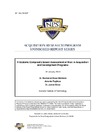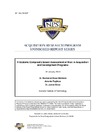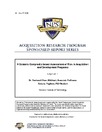A Systems Complexity-Based Assessment of Risk in Acquisition and Development Programs
| dc.contributor.author | Pugliese, Antonio | |
| dc.contributor.author | Nilchiani, Roshanak Rose | |
| dc.date | 2017-03 | |
| dc.date.accessioned | 2018-06-13T17:09:52Z | |
| dc.date.available | 2018-06-13T17:09:52Z | |
| dc.date.issued | 2017-03 | |
| dc.identifier.uri | https://hdl.handle.net/10945/58841 | |
| dc.description.abstract | Development and acquisition efforts of cyberphysical systems can often encounter cost or schedule overruns due to the complexity of the system. It has been shown that a certain amount of system complexity is related to the system functionalities (effective complexity), whereas excessive complexity is related to unnecessary intricacies in the design (apparent complexity). While the former is necessary, the latter can be removed through precise local redesign. One of the major challenges of systems engineering today is the development of tools, quantitative measures, and models for the identification of apparent complexity within the system. This research has the goal of evaluating and measuring the structural complexity of the engineered system, and does it through the analysis of its graph representation. The concepts of graph energy and other spectral invariant quantities allow for the definition of an innovative complexity metric. This metric can be applied knowing the design of the system, to understand which areas are more in need of redesign so that the apparent complexity can be reduced. | en_US |
| dc.description.sponsorship | Naval Postgraduate School Acquisition Research Program | en_US |
| dc.publisher | Monterey, California. Naval Postgraduate School | en_US |
| dc.rights | This publication is a work of the U.S. Government as defined in Title 17, United States Code, Section 101. Copyright protection is not available for this work in the United States. | en_US |
| dc.title | A Systems Complexity-Based Assessment of Risk in Acquisition and Development Programs | en_US |
| dc.type | Presentation | en_US |
| dc.identifier.npsreport | SYM-AM-17-120 |





